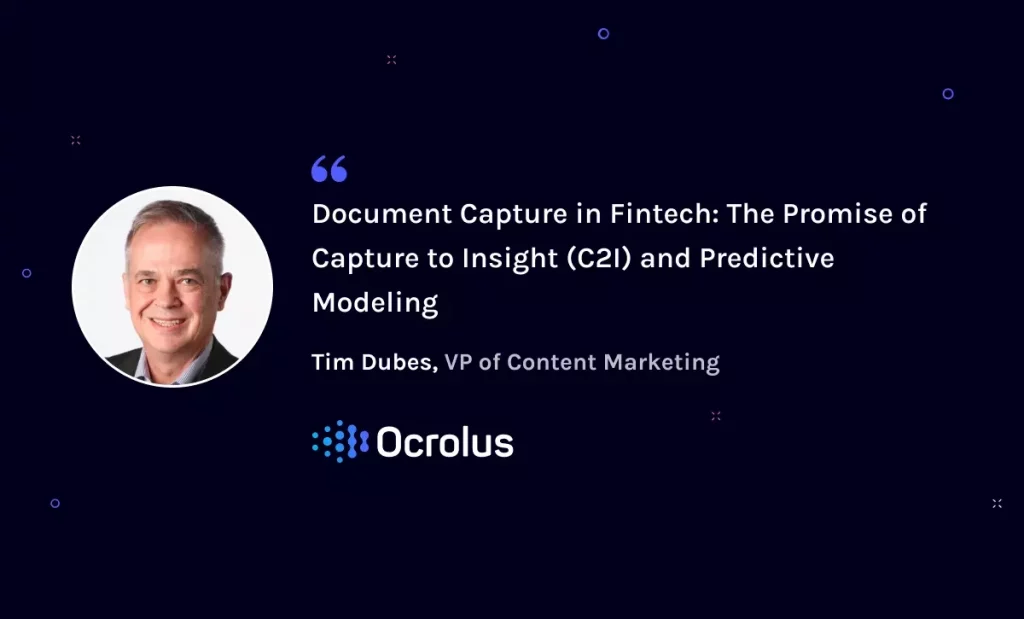Document Capture in Fintech: The Promise of Capture to Insight (C2I) and Predictive Modeling

Six years ago, I wrote about the changing value proposition for advanced document capture, which I referred to as Capture 3.0 and applied horizontally across industries. This perspective was an extension of the industry’s definition of digitizing unstructured content. The industry-accepted generational term of Capture 2.0 has applied to digitizing and extracting data from other unstructured sources: video, audio, emails, and web pages, as well as the application of automated workflows.
To me, it has always been more important to focus on the application of the extracted data rather than the source. Here are the major innovations in document capture technology.
Document Capture Technology Maturity: Process Automation to Predictive Modeling
Capture to Archive (C2A)
C2A is the process of taking a document after its active life and digitizing the file and a few key fields that could be used to later track down the document. The benefits of C2A are reduced document storage costs and expedited research. You could find archived documents faster via a federated search across digital repositories rather than a room full of file cabinets. The main application for C2A is records management.
Capture to Process (C2P)
C2P involves digitizing documents as early in a workflow as possible, reducing data entry costs, and accelerating approval times. This model has been effective for invoice processing, insurance claims processing, and–in the fintech world–faster underwriting decisions.
Capture to Insight (C2I)
Lastly, there’s capture to insights, or C2I, which is the process of taking the collective data from all document-driven or document-support transactions and using it to identify patterns and develop models that improve workflows and decisioning.
In 2015, the legacy capture vendors were hyper-focused on robotic process automation (RPA), and the concept of extracting insight from the collective processes failed to materialize. It hasn’t been until new solution providers and innovators entered the market that conceptual C2I has become a reality, and in fact, has unlocked the strategic value of document capture.
Scale & specificity the keys to unlocking C2I value
I bring up this concept from 2015, not to take Nostradamus-like credit for seeing into the future, but rather to relate how this concept has now become a reality within the fintech market and how it truly magnifies the value of digitizing content. In 2015, the concept of C2I was around onboarding documents into a big data analytics model. It was the idea that the majority of information was trapped in unstructured content and thus couldn’t be applied to big data analytics.
Today, the application of C2I for fintech has grown via a focus on specific document types, such as the core documents that lenders use to qualify borrowers and make underwriting decisions: bank statements, pay stubs, and tax forms. For example, Ocrolus has processed over 85 million pages of these financial documents since I wrote that original article in 2015. Certainly, that experience results in capture to process efficiencies: lenders can make underwriting decisions based on borrower-supplied documentation without key entry delays or errors.
Yet, there is a cumulative value to that experience with loan documentation, which allows Ocrolus to provide analytics that enables lenders to modify underwriting models to account for cash flow lending risk and other indicative factors.
The recollection of the Capture 3.0 prognostication came to mind last month as I was having a video discussion with the Chief Risk Officer from one of Ocrolus’ fintech partners. Like many successful fintech lenders, her company has embraced the competitive advantages of cloud computing and applied data science to provide faster, transparent customer service. In this case, the service was capital funding to over 24,000 small businesses in the US, Canada and the United Kingdom.
The CRO explained how their engagement with Ocrolus has allowed customers to submit their bank statements online, with document automation enabling underwriters to perform asset and cash flow analysis to determine approvals and interest rates. She cited the expected benefits: cost savings on data entry and faster lending decisions, leading to greater customer satisfaction.
The big predictive modeling story however, was the cumulative effect of processing over a million bank statements on the platform. By examining the data extracted from those documents–particularly with the hindsight of the performance from funded loans–the lender was able to refine and optimize its models for pricing and risk. She described the retro-analysis of bank statements as “a treasure trove of data in PDF format.” Turning that unstructured content into meaningful, decisionable data was instrumental in building out their credit risk and loan sizing models.
Elevating document capture automation to a strategic technology
To understand why Capture 3.0 is now coming into the spotlight, it helps to look at the business professionals impacted by its use. The Chief Risk Officer’s organization has half a dozen data scientists who continue to refine their credit and risk models to account for different industries, geographies, and seasonality. This enables the lender to develop profitable, market-competitive lines of credit and loan offerings to business customers with competitive pricing.
Document capture that makes data scientists more effective creates significantly more value than making data entry operators more efficient (C2A) or business processes more efficient (C2P). Hence, the push for moving from business process automation to predictive modeling, or C2I.
The analytics available for credit modeling is just one application for advanced document capture solutions. Evaluating the extracted data along with other available data sets–both structured and unstructured–can produce insights that lenders can use to a competitive advantage and discover new business opportunities. That is the promise and potential of Capture to Insight (C2I) technology.
Ready to learn more about document capture automation through Ocrolus? Schedule a demo today.


